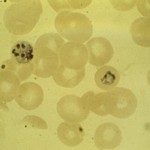Link to Pubmed [PMID] – 37098534
Link to DOI – 10.1186/s12936-023-04570-x
Malar J 2023 Apr; 22(1): 136
Measuring risk of malaria transmission is complex, especially in case of Plasmodium vivax. This may be overcome using membrane feeding assays in the field where P. vivax is endemic. However, mosquito-feeding assays are affected by a number of human, parasite and mosquito factors. Here, this study identified the contributions of Duffy blood group status of P. vivax-infected patients as a risk of parasite transmission to mosquitoes.A membrane feeding assay was conducted on a total of 44 conveniently recruited P. vivax infected patients in Adama city and its surroundings in East Shewa Zone, Oromia region, Ethiopia from October, 2019 to January, 2021. The assay was performed in Adama City administration. Mosquito infection rates were determined by midgut dissections at seven to 8 days post-infection. Duffy genotyping was defined for each of the 44 P. vivax infected patients.The infection rate of Anopheles mosquitoes was 32.6% (296/907) with 77.3% proportion of infectious participants (34/44). Infectiousness of participants to Anopheles mosquitoes appeared to be higher among individuals with homozygous Duffy positive blood group (TCT/TCT) than heterozygous (TCT/CCT), but the difference was not statistically significant. The mean oocyst density was significantly higher among mosquitoes fed on blood of participants with FY*B/FY*BES than other genotypes (P = 0.001).Duffy antigen polymorphisms appears to contribute to transmissibility difference of P. vivax gametocytes to Anopheles mosquitoes, but further studies are required.

